LisbonLisboaPortugal.com
The best independent guide to Central Portugal
LisbonLisboaPortugal.com
The best independent guide to Central Portugal
Tomar, Portugal: an independent travel guide for 2025
Tomar is one of Portugal's most fascinating and historically significant towns, forever linked to the enigmatic Knights Templar. For centuries, this was one of the most influential places on the Iberian Peninsula, first as the religious headquarters of the Knights Templar and later their successors, the Order of Christ.
Their legacy is best seen in the mighty Convento de Cristo, the very complex from which they dominated Portuguese society. Originally a Templar castle, it was expanded over centuries into one of the most magnificent religious buildings in all of Portugal.
Beyond its important history, Tomar is also one of central Portugal's most charming towns. It sits proudly on the banks of the Nabão River, its delightful historic centre a maze of cobbled streets, traditional houses, and ancient churches.
While Tomar can be visited on a day trip, its calm ambience and authentic character reward those who choose to stay longer. The town serves as an excellent base for exploring the wider region, with easy trips to Fátima, Batalha, and the stunning Castelo de Almourol.
This guide provides everything you need for a perfect visit, offering practical travel information, a walking tour, and insider tips, to help you make the most of your time here.
Highlights of Tomar
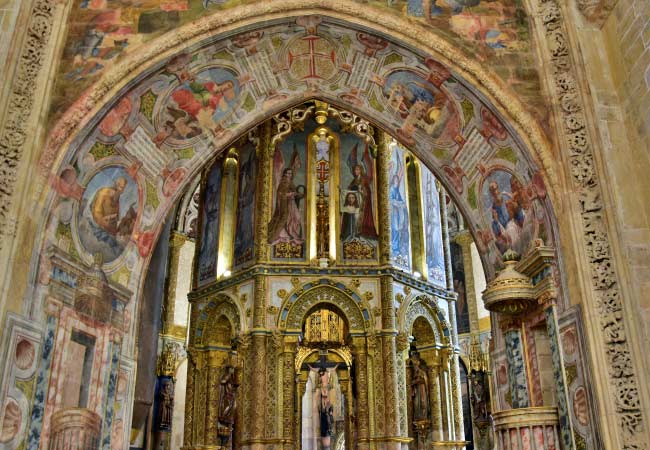
The Charola - The magnificent centrepiece of the Convento de Cristo, the Charola is a 16-sided Templar chapel inspired by the Holy Sepulchre in Jerusalem. Its unique design allowed the warrior monks to attend mass on horseback, while the walls are adorned with vivid 16th-century artworks that make this the undeniable highlight of any visit to Tomar.
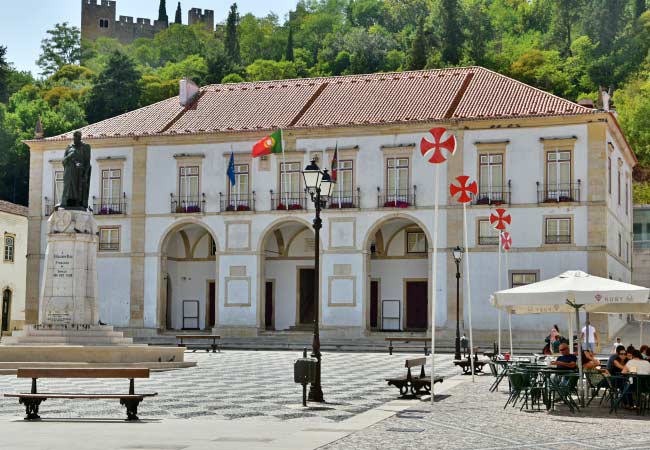
The historic centre – The heart of Tomar is its delightful historic centre. It's a joy to explore, from the pretty banks of the Nabão River to the medieval streets lined with traditional houses. At its centre, you will find the grand Praça da República, a beautiful plaza presided over by the São João Baptista church.
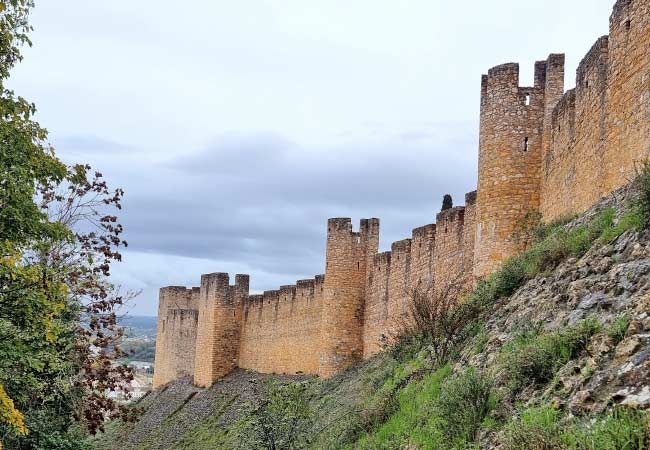
The Castelo de Tomar - Guarding the town from the hilltop is the sprawling 12th-century Castelo de Tomar. This fortress once protected the ancient Roman road between Santarém and Coimbra before becoming the defensive walls for the Convento de Cristo.
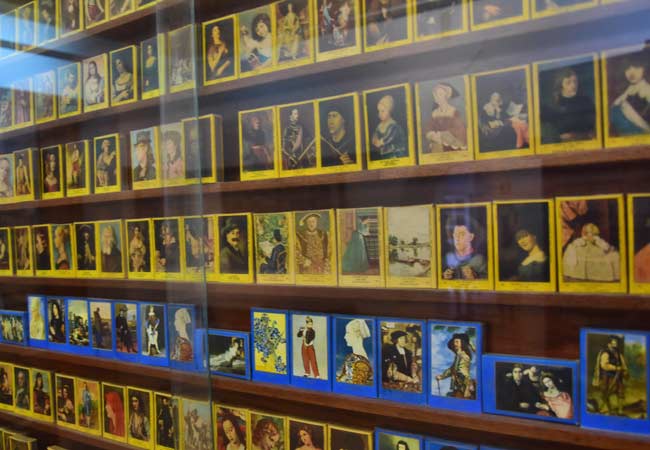
The Museu dos Fósforos – This quirky and fascinating museum houses the world's largest private collection of matchboxes, whose colourful designs depict the changing trends, art, and fashions of their eras.
Related articles: Sights of Tomar
A day trip to Tomar
A day trip to Tomar from Lisbon is possible, but it will be an extremely long day due to the distance involved. From Lisbon, the journey to Tomar takes 90 minutes by car or two hours by train each way. Fortunately, the train is direct, inexpensive and hassle-free.
Tomar makes for an excellent day trip if you are based on the Silver Coast in towns like Nazaré or Peniche. However, public transport from this region is very limited, so a car is essential.
Regardless of how you arrive, all of Tomar's main attractions are located within the historic centre and are easily explored on foot.
Below is an interactive map for a suggested day tour of Tomar. (Note: zoom in and out to see all of the points).
Sights during the tour: 1) Sinagoga de Tomar 2) Igreja de São João Baptista 3) Câmara Municipal de Tomar 4) Porta de São Tiago/ Castelo dos Templários 5) Charola - Convento de Cristo 6) Claustro dos Corvos - Convento de Cristo 7) Nossa Senhora da Conceição 8) Jardim da Várzea Pequena 9) Núcleo de Arte Contemporânea 10) Mouchão Parque 11) Mata Nacional dos Sete Montes 12) Igreja do Convento de São Francisco 13) Museu dos Fósforos 14) Igreja de Santa María dos Olivais
Note: The suggested walking tour above would take around 3 to 4 hours, or longer if you include lunch.
Tours to Tomar
If you are short on time but would still like to discover the region north of Lisbon, an organised tour can be a fantastic option. Along with removing the hassle of public transport, organised tours provide knowledgeable guides and can combine multiple destinations into a single day.
We have worked with GetYourGuide for seven years, and some of their best tours that include Tomar are:
• Knight Templar small group tour, from Lisbon
• Tomar and Almourol Castles group tour, from Lisbon
• Tomar and Almourol as a private tour
• Tomar and the Knights Templars private tour
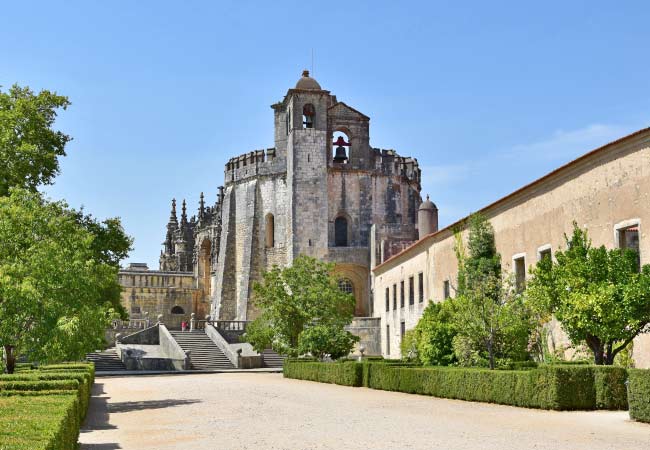
Der beeindruckende Kloster- und Burgkomplex Convento de Cristo erhebt sich über Tomar.
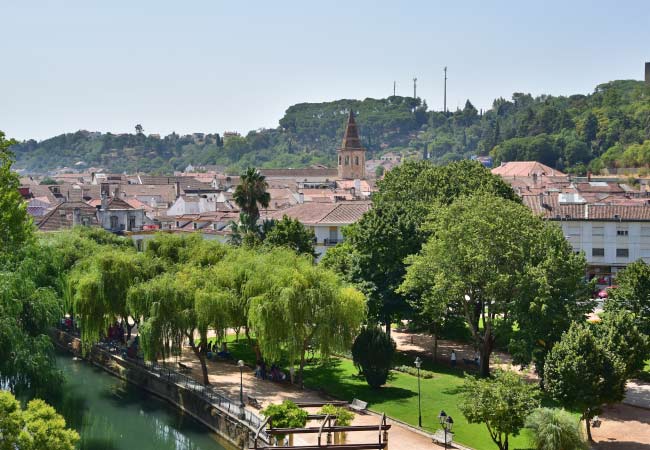
The peaceful Parque do Mouchão follows the banks of the Nabão river
Who Should Visit Tomar?
Tomar is a key destination for any visitor interested in Portugal's history, particularly the legacy of the Knights Templar. Unlike more crowded tourist hubs such as Sintra or Óbidos, Tomar offers a more authentic and calmer experience. Here, the town's atmosphere is shaped by local life rather than tourism, allowing visitors to experience a more genuine side of central Portugal.
Tomar acts as the perfect counterbalance to the hectic pace of the big cities. Days are often spent enjoying long meals or socialising in small cafés and bars in the evening. While some visitors may find Tomar too quiet, for many others, it represents the perfect idyllic Portuguese dream – which is why it has become such a popular location for foreigners to settle.
Because its main attractions are historical, the town is generally less suited for families with young children.
Tomar's location also makes it a highly recommended stop on any tour of central Portugal, fitting perfectly into an itinerary between Lisbon and Porto. A popular travel plan is Lisbon (3 days), Tomar (1 day), Coimbra (1 day), and Porto (2 days).
Related articles: Lisbon guide - Coimbra guide - Porto guide
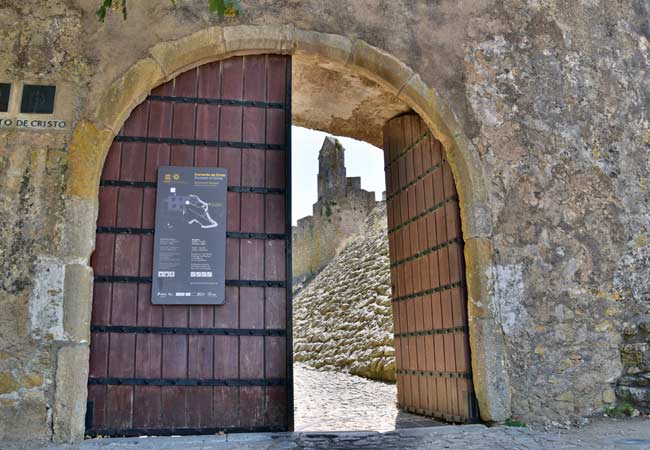
Porta de São Tiago is the main gate to the Castelo dos Templários
Why Stay for More Than a Day Trip?
While Tomar's main sights can be seen in one day, staying for at least one night is highly recommended. A longer stay allows you to use Tomar as an excellent base for exploring the many fascinating sites in the surrounding region.
A second day, for example, provides the opportunity to visit the unique Templar castle of Almourol, set on an island in the Tejo River. Other easy day trips include the magnificent UNESCO monasteries at Batalha and Alcobaça, and the major pilgrimage town of Fátima. Close by is Ourém, which boasts all the scenic charm of Óbidos but without the tourist crowds.
The region also boasts significant natural attractions. You can explore a remarkable network of underground caves, including the Grutas de Mira de Aire, the largest in Portugal, as well as the nearby Grutas da Moeda and Grutas de Santo António. For a different type of natural beauty, the vast Castelo do Bode reservoir offers a day of swimming, kayaking, and other water sports.
Finally, staying longer simply allows you to slow down and enjoy the town's peaceful and authentic atmosphere, a major reason many visitors fall in love with Tomar.
Where to Stay in Tomar
Tomar offers excellent accommodation options ranging from historic luxury hotels to charming guesthouses.
Luxury & Historic Hotels
Hotel dos Templários (4-star) - The grand dame of Tomar hotels, this 167-room property sits beside the Nabão River surrounded by majestic gardens. Features include multiple pools, extensive grounds, and professional service. Perfect for those seeking traditional comfort with resort amenities.
Vila Galé Collection Tomar (4-star) - A stunning conversion of the former Convent of Santa Iria, this hotel brilliantly fuses contemporary design with Templar history. The 100 stylish rooms, Satsanga Spa, and spectacular décor make it ideal for romantic getaways.
Thomar Boutique Hotel (4-star) - More than a hotel, it's a journey through time. Each floor represents a different era: Roman, Templar, Age of Discovery, and Industrial. The rooftop terrace offers panoramic views of the castle. Perfect for history enthusiasts.

The Hotel dos Templários
Mid-Range & Boutique Options
Casa dos Ofícios Hotel (4-star) - This intimate eco-certified hotel occupies a beautifully restored 18th-century family home. Rooms are themed around traditional crafts, and the personal service is exceptional.
Estalagem de Santa Iria (4-star) - For a romantic escape, this 20-room hotel on an island in the Nabão River offers tranquility and charm. The setting within Mouchão Park is idyllic.
Guest Houses & Budget Options
Hotel Kamanga (2-star) - Highly rated budget option offering comfortable rooms and excellent value in the town center.
Thomar Story Guest House - Set in a 19th-century riverside building, each of its 12 rooms tells part of Tomar's story through themed décor.
The map below shows the location of the hotels and rental rooms in Tomar. If you adjust it to your holiday dates it will display current prices and availability.
Booking.comWhere to Eat in Tomar
Tomar's culinary scene reflects its Ribatejo heritage - honest, hearty, and traditional. From destination restaurants to local tascas, there's something for every taste and budget.
Chico Elias (€€€) - Family-run since 1963, famed for its unwavering commitment to the original recipes of its matriarch, all cooked to perfection in a traditional wood-fired oven. The ambiance is rustic and authentic, and the menu features historic dishes like slow-roasted rabbit stuffed with pumpkin.
Bela Vista (€€) - As its name suggests, "Beautiful View" is celebrated for its enchanting and romantic setting. Guests dine on a veranda draped in century-old wisteria vines, with a stunning panorama of the Templar Castle and the Nabão River. The food is reputed to be among the best in the region.
Taverna Antiqua (€€) - This restaurant offers a unique form of culinary time travel. Located in a cave-like space in the old town square, it provides a full medieval dining experience, complete with candlelight, wooden benches, and costumed staff. The menu is inspired by historical recipes, featuring dishes like wild boar pie and ham hock. Bookings are essential for this popular and immersive experience.
O Tabuleiro (€) - A beloved local spot located just off the main Praça da República, O Tabuleiro is the epitome of traditional Portuguese home cooking. It is known for serving hearty, flavourful dishes in generous portions
Biscaia (€) - For a quick, delicious, and quintessentially local lunch, Biscaia is an unmissable, no-frills gem.
Casa das Ratas (€/€€) - As one of Tomar's oldest traditional taverns, or tascas, Casa das Ratas offers the perfect place to sample simple, well-prepared local dishes in a lively, unpretentious atmosphere.
Café Paraíso (€) - More than just a café, this is a historic institution that has been a central meeting point on Tomar's main pedestrian street since 1911. It retains its old-world charm and is a favourite among locals for its relaxed atmosphere and inexpensive drinks.
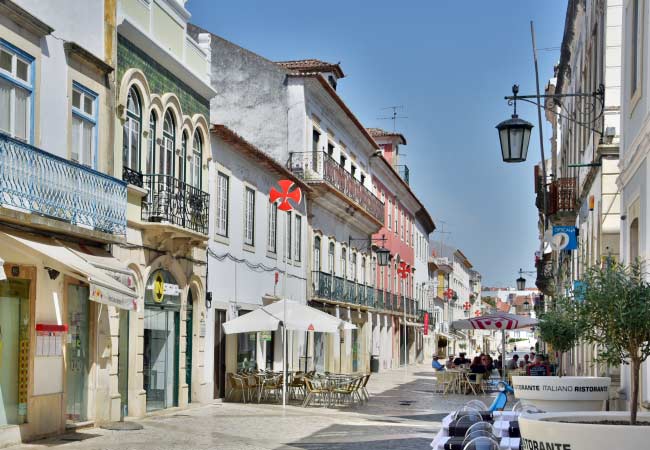
Why is Tomar connected to the Knights Templar?
Tomar was established as the religious centre for the Knights Templar by the Grand Master Gualdim Pais in 1160. The lands surrounding Tomar and Santarem were gifted to Pais by King Afonso Henriques for his services during the Battle of Ourique, in which the Christian Crusaders defeated the North African Moors.
This close association of the Knights Templar with the Portuguese monarchy allowed the establishment of the Order of Christ after Pope Clement V disbanded the Knights Templar in 1312.
It is widely believed that the Order of Christ provided the knowledge and funding that began the ‘Portuguese Age of Discovery’, in which Portuguese explorers crossed the oceans.
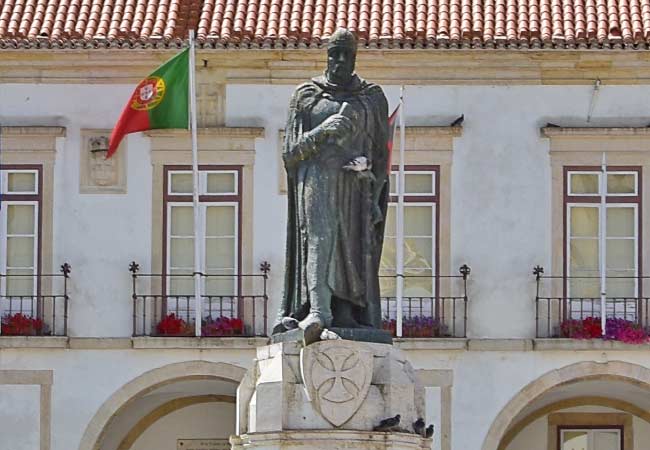
The statue of Gualdim Pais stands in front of Tomar town hall
Travel to Tomar
Lisbon is connected to Tomar by a direct but slow regional train service. The train takes 2 hours, and the fare is €10.85/ €19.40 (adult single/return), which does make it possible to visit Tomar as a day trip.
In Lisbon, the train departs from the Santa Apolónia station and passes through the Estação do Oriente. The latest timetable can be seen on the Comboios de Portugal (CP) website:
www.cp.
In Tomar, the train station is located to the south of the historic centre, GPS 39.598, -8.413 (link to google map) and is situated next to the bus station. From the train station it is an 8-minute walk to the Praça da República and a 17-minute walk to the Convento de Cristo entrance.
The town is often visited as part of a tour of central Portugal, but there is limited public transport to the surrounding region. There are bus services from Tomar to Fatima, provided by the RodoTejo bus company: www.rodotejo.pt/. For intercity express buses from Tomar, see the Rede Expressos website: rede-expressos.pt
The best way to travel between Coimbra and Tomar is by train, but the journey is not direct and will require a connection. The regional train service costs €10.35 and takes around 2 hours 25 minutes. There are more expensive express trains, and full details can be seen on the Comboios de Portugal (CP) website. www.cp.pt
Related articles: Lisbon to Tomar
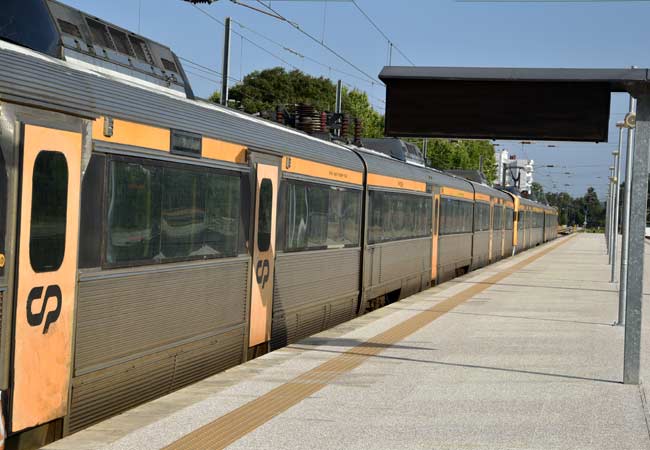
Tomar train station is the final stop along the railway
The Convento de Cristo
The Convento de Cristo rises from Tomar's highest hill like a stone chronicle of Portuguese ambition, its walls containing seven centuries of accumulated power, mysticism, and architectural audacity. This UNESCO World Heritage site began in 1160 as Portugal's Templar headquarters – a fortress-monastery where warrior-monks plotted crusades and accumulated the wealth that would later finance an empire.
The complex tells its story through stone: Romanesque fortifications give way to Gothic chapels, Manueline flourishes burst from medieval walls, and Renaissance cloisters impose mathematical order on sacred space. When Pope Clement V dissolved the Templars in 1312, Portugal's King Dinis performed an audacious sleight of hand, creating the Order of Christ in 1319 and transferring all Templar assets to this "new" organization. The red Templar cross simply gained a white border, ensuring Portugal retained the wealth and knowledge other European nations lost.
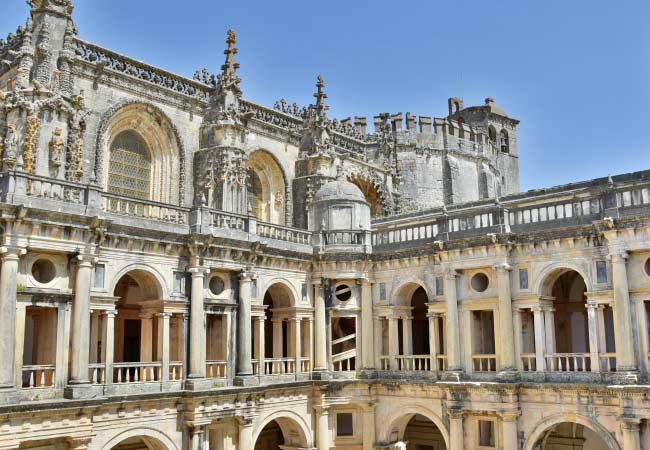
The Charola
The heart of the complex beats in the Charola, the enigmatic round church constructed in 1162. Gualdim Pais, the Templars' first Portuguese Grand Master, modelled it after Jerusalem's Church of the Holy Sepulchre, 16 sides on the exterior, eight within. This design served both practical and mystical purposes: mounted knights could circle the altar during ceremonies, while the geometry channelled what Templars believed to be divine energy.
The austere 12th-century structure conceals a lavish interior transformed by Dom Manuel I. Sixteenth-century artists covered every surface with gilded woodwork, vibrant frescoes, and polychromatic statues. Recent archaeological work discovered the building's orientation aligns with specific astronomical events, suggesting the warrior-monks incorporated celestial observations into their architectural planning.
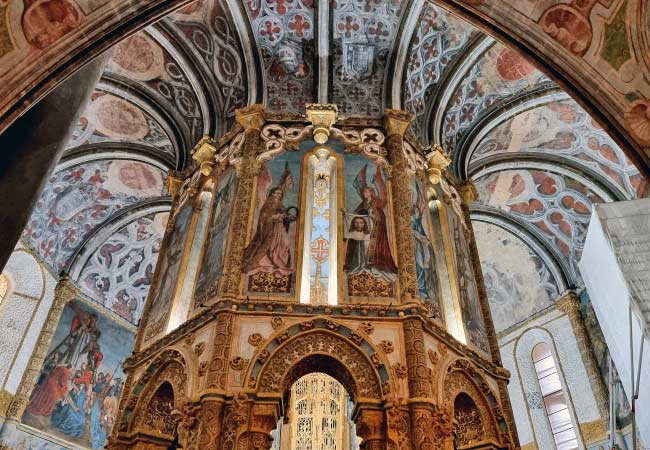
The magnificent 16-sided Charola with its octagonal interior, inspired by Jerusalem's Holy Sepulchre
The convent
The convent's architecture reads like a textbook of Portuguese styles. Dom Manuel I's most dramatic intervention came in 1510 when he literally broke through the Charola's wall to add a nave, commissioning Diogo de Arruda to create the famous Chapter House Window. This Manueline masterpiece took seven years to complete, its 14 meters of carved stone celebrating maritime glory through coral-encrusted columns, rope motifs and armillary spheres.
Eight distinct cloisters spread throughout the complex, each built in a different era. They tell the story of the convent's evolution through their changing architectural styles.
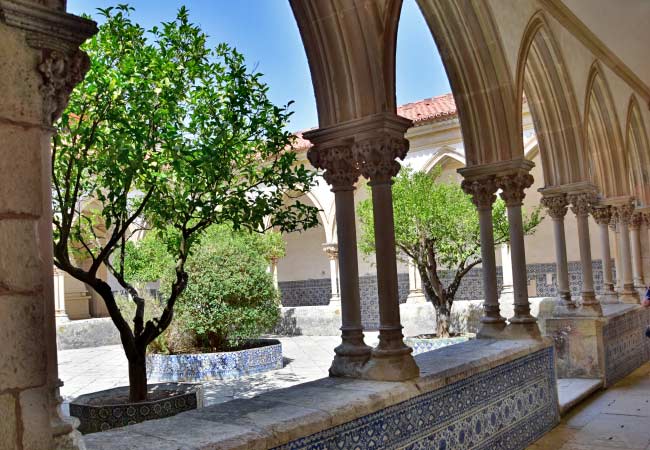
The Gothic Cemetery Cloister dates from the 15th century, built when Prince Henry the Navigator served as Grand Master. Its delicate twin columns and peaceful atmosphere create a space for quiet contemplation.
The Main Cloister represents the height of Portuguese Renaissance architecture. Diogo de Torralva designed this masterpiece between 1557 and 1562, using perfect mathematical proportions to create harmony and balance. Elegant spiral staircases rise from each corner, while the upper galleries offer spectacular views across the complex.
The Washing Cloister served a practical purpose, this is where monks scrubbed their robes clean. The original stone washing tanks remain in place, a reminder that daily life in the monastery required mundane tasks alongside spiritual duties.
The complex conceals secrets recently revealed: a network of defensive passages, false doors, and stairs leading nowhere. In 2019, archaeologists discovered a sealed chamber behind the Charola's altar containing 12th-century documents, walled up for 700 years. The massive Renaissance cistern beneath the Main Cloister could sustain the monastery through extended sieges.
Sights of Tomar
Beyond the Convento de Cristo Tomar has a selection of equally fascinating sights and attraction:
Museu Dos Fosforos
The Museu Dos Fosforos houses the world’s largest collection of matchboxes and is a world-class art gallery and museum, but on a miniature scale!
This incredibly niche museum has been beautifully curated to reflect the values and changing interests of the world’s smokers from 1890 to the 1980s, spanning over 125 countries. The box artwork is so varied; certain box sets celebrate the achievements of countries, while other sets are humorous and sometimes controversial.
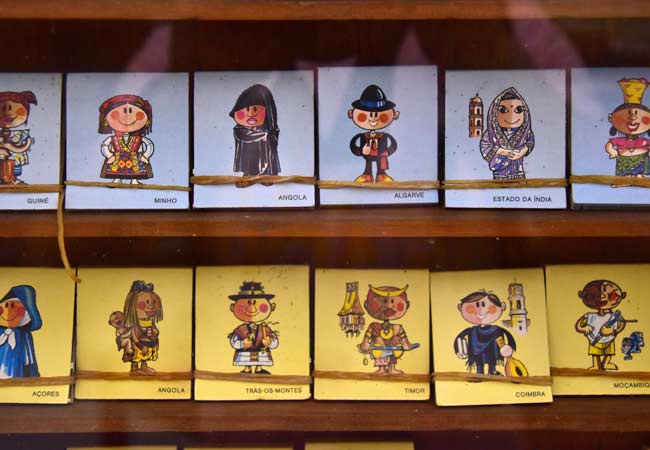
Matchboxes from the 1950s depicting Portuguese characters from the different regions
Sights of Tomar - Igreja de São João Baptista
The Igreja de São João Baptista, a 15th-century Catholic church, features Manueline architecture and was constructed under King Manuel I, dedicated to Saint John the Baptist.
This national monument, situated in Tomar's main square, boasts a flamboyant Gothic portal, a Manueline tower with a 16th-century clock, and interior columns with decorated capitals, alongside panels painted by renowned Renaissance artist Gregório Lopes.
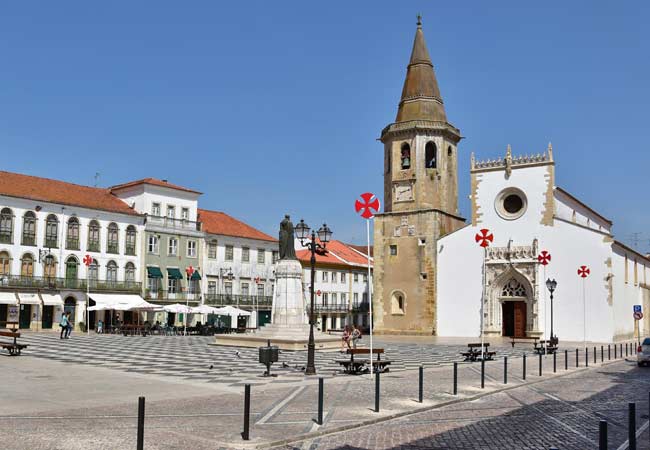
The Igreja de São João Baptista sits on the on the Praça da República, the main plaza of Tomar
The Igreja de Santa María do Olival
The Church of Santa María do Olival, established in the 12th century by Gualdim Pais of the Knights Templar, serves as a historic resting place for Templar knights and later the Order of Christ.
Renowned for its early Gothic architecture, this national monument features a distinct, free-standing bell tower, a rose window, and an interior marked by a Gothic ribbed vault and pentagram-shaped tracery on the nave's eastern wall.
Within the church is the tomb of Gualdim Pais, who died in 1195.
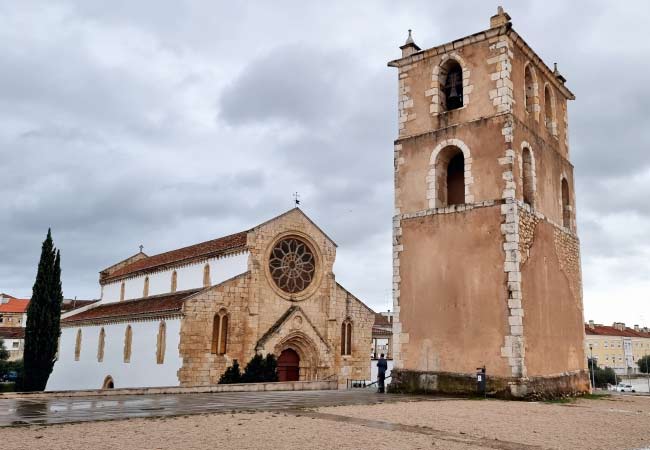
Igreja de Santa María do Olival
The Sinagoga de Tomar
The Sinagoga de Tomar is a medieval synagogue constructed between 1430 and 1460. It is one of Portugal's two pre-expulsion synagogues, and today houses the Abraham Zacuto Portuguese Jewish Museum.
The synagogue served Tomar's significant Jewish community, which formed around the 14th century, and functioned actively until the expulsion of Jews in 1496. Later it had various uses, including a Catholic chapel and a warehouse.
The building is architecturally discreet, with a whitewashed exterior that is only marked by a Star of David above the doorway. Its interior features Gothic vaulting supported by columns symbolizing the four matriarchs and twelve brackets representing the Twelve Tribes of Israel.
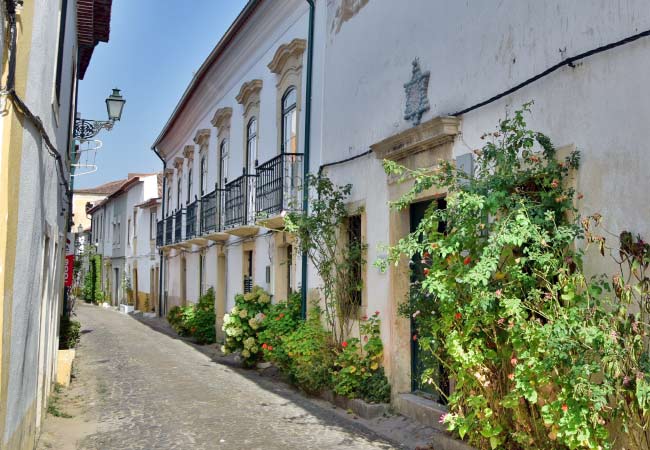
The entrance to the Sinagoga de Tomar
Discover more of central Portugal with our guides

























